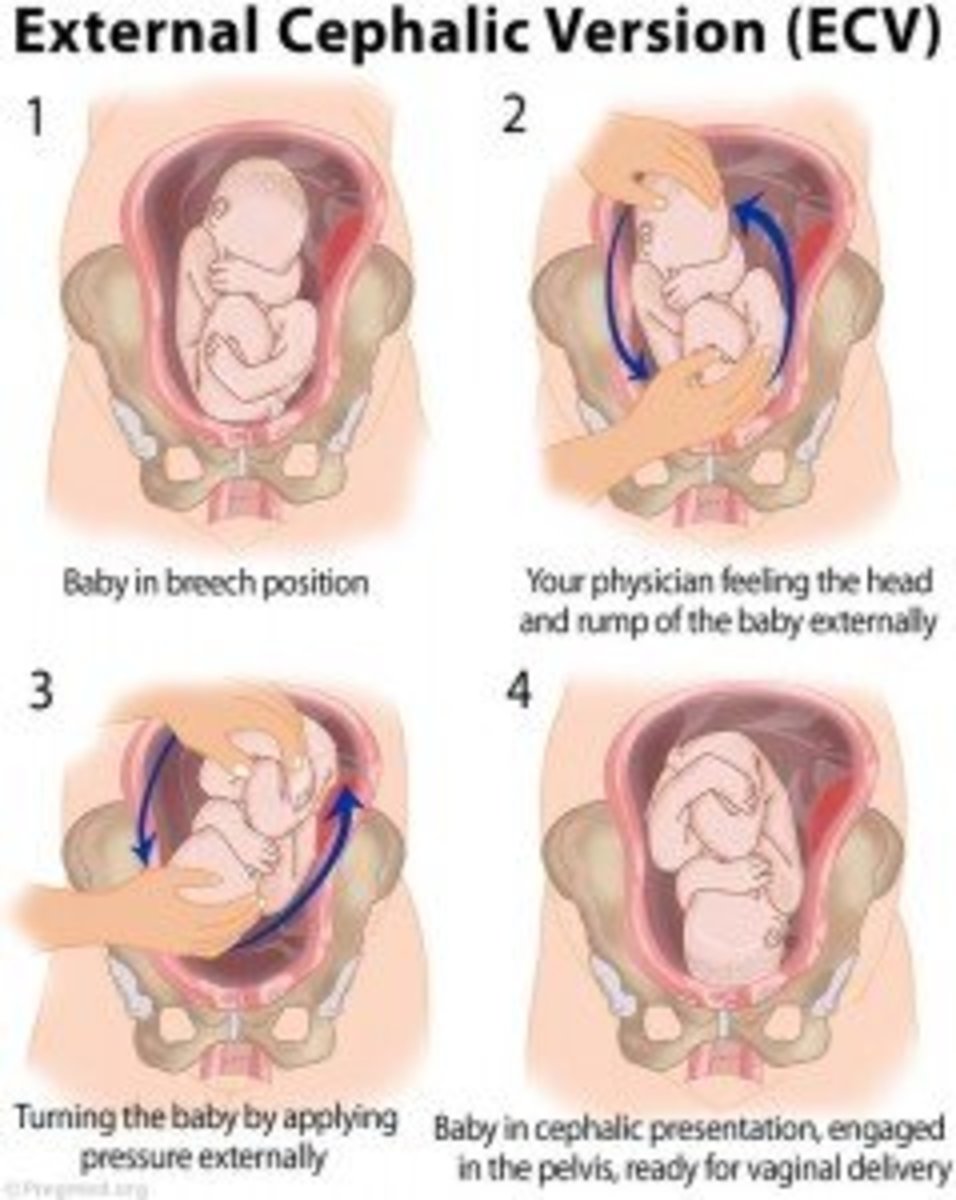- HubPages»
- Health»
- Women's Health»
- Pregnancy
Pain Management During Labor and Delivery

Individual Choices in Pain Management during Labor and Delivery
Good pain relief during labor and delivery is important. It allows the mother to be comfortable and remain in control of the birthing process which helps the labor to progress as it should. It is important to know that good pain relief does not always involve total elimination of pain. Most women expect some pain during labor but if the pain gets to the point that they do not feel in control, their fear and anxiety will increase the pain which will slow down the labor. Since pain is subjective everyone has their own individual limit on the amount of pain they are comfortable with. There are two broad methods of pain management: pharmacologic control and non-pharmacologic control. These methods can be combined or used alone during labor and delivery.

Pharmacologic Pain Management
As labor progresses the two pharmacologic approaches to relieving pain are analgesics and anesthetics. Analgesia works in the brain to alter perception of pain. With an analgesic the woman may still have some discomfort but it will be less intense. Analgesics enter the bloodstream and can be transferred to the baby through the placenta and suppress breathing at birth. In most cases the baby should be able to metabolize the drugs before delivery (Analgesia). The infant may have respiratory depression if a narcotic analgesic is administered within two hours of delivery. Narcotic analgesics used include Stadol, Nubain, Fentanyl, Demerol/Phenergan, and Morphine (Olds, London, Ladewig, & Davidson, 2004). Some women will have some itching of the nose and face or occasional nausea and vomiting from the use of narcotics.
Anesthesia works directly on the nerves to block sensation. The anesthetized area becomes numb and there should be no pain at all. There are different types of anesthesia that work in different ways. These include local, pudendal block, and regional blocks. All of these types of anesthesia will give temporary numbness in a limited area without any loss of consciousness (Olds et al., 2004).
Local anesthesia is typically injected in the area between the vagina and rectum if an episiotomy is to be performed. This procedure rarely has any complications to mother or infant due to the small amount of anesthetic used (Olds et al., 2004). In a pudendal or para cervical block the anesthetic agents are injected into the walls of the vagina and sometimes around the cervix to ease pain associated with labor and delivery. This does not relieve the actual pain of contractions but only the pain from perineal distention. Advantages are the ease of administration, absence of maternal hypotension and little effect on the fetus. A decreased urge to bear down is a disadvantage to this method (Olds et al., 2004).
Regional blocks are given by injecting medication near the nerves in the spinal cord to block sensation in larger areas. Regional blocks numb your body from your midsection down (Olds et al., 2004). Common regional blocks are epidural and spinal blocks. In epidural analgesia a needle is inserted between the vertebra of the spinal column and into the space just outside the dural membrane (Henry & Nand, 2004). Epidurals usually provide good pain relief, but occasionally they fail to eliminate any or all of the pain. This could be due to problems with getting the appropriate needle position required because of labor discomfort or anatomic characteristics (Analgesia). This causes no pain relief or pain relief to only one side of the body. Also, individuals vary in their response to medications so some medications may not work as well for some people. Other disadvantages include maternal hypotension, delayed analgesia onset, and delayed labor if given early in labor. Spinal analgesia is administered when the needle is advanced past the epidural space into the spinal fluid. It has an immediate onset of anesthesia, requires a smaller drug volume and is easier to administer. A high incidence of hypotension and spinal headache are some of the disadvantages to spinal analgesia (Olds et al., 2004).
Adverse effects of anesthetic agents can include nausea, shivering, pruritus, vertigo, dizziness, apprehension, confusion, allergic reactions, and urinary retention. Sudden loss of consciousness, coma, and cardiac arrest are more serious but rare reactions. Accidental intravenous injection causes systemic toxic reactions including convulsions and sudden cardiovascular collapse. All adverse maternal reactions have an affect on the fetus. Regional anesthetics are sometimes combined with narcotics to provide more intense pain relief (Olds et al., 2004).
Do you have a birthing plan in place to give your caregivers?
Non-pharmacologic Pain Management
There are many different non-pharmacologic methods of pain management for women to choose. Some of these include paced breathing, activity/position change, massage or therapeutic touch, Lamaze, visualization, relaxation, hydrotherapy (getting in a bath, shower, Jacuzzi), music therapy, hypnosis and psychosocial support (Henry & Nand, 2004). The main disadvantage to most of these is that the woman has to learn how to use the method effectively before they are in labor. Fortunately, there are many classes and resources for expectant mothers to learn any method they choose.
A method that does not require advance training is activity and position change during labor. The ability of the mother to change her position during labor has been shown to shorten the length of labor and decrease the use of medications in labor. Activity and positions include walking around, sitting in a rocking chair,birthing ball or birth stool, squatting on haunches, getting on hands and knees, or assuming whatever position feels most comfortable (Olds et al., 2004). Elimination of pain is not expected but rather a decreased pain which increases positive feelings of childbirth (Analgesia). There are no adverse effects for mother or fetus. Expectations should be to decrease pain during labor which will reduce stress on the fetus.
Personal Opinion
During labor and delivery it is best to do what makes the woman most comfortable since her comfortable level will determine the progress of labor. Many people are afraid of the side effects and possible complications that medications could have on the infant, so they may be hesitant to use any medications. On the other hand, some women may not be able to deal with a lot of pain and will do better using medications during labor. The most important thing expecting mothers should know is that medications may not work how they expect them to. They need to be educated in all choices, possible effects, and side effects. Some women may think that if they have an epidural they will definitely not have any pain, but that may not always be the case. They should be prepared to use other methods of pain management if the method of their choice does not work for them. It is great that some women can go through labor without any medications but women should know that there is not anything wrong with wanting or needing the help of medications during labor.
Conclusion
Pain is different for everyone, so the management of pain should also be different for everyone. There are many different pharmacologic methods for pain management. The risks to the fetus are increased when medications are used but there are also increased risks if the mother is in extreme pain. In most cases pharmacologic methods are safe for reducing pain and increasing positive feelings of labor which helps in subsequent labor and deliveries. Non-pharmacologic methods do not have any risk for the fetus or mother. These methods are very effective when combined with each other and many mothers require less medication than those who only choose pharmacologic methods. Due to the individual effects and responses to pain management the expecting mother should start learning about the different methods early to prepare and find out which methods will work best for her.
References
Analgesia. (n.d.). Retrieved Mar. 02, 2005, from www.birthpsychology.com Web site: http://www.birthpsychology.com/messages/analgesia/analgesia.html.
Henry, A., & Nand, S. (2004). Intrapartum pain management at the royal hospital for women [Electronic version]. Australian & New Zealand Journal of Obstetrics & Gynecology, 44(4), 307-313
Olds, S., London, M., Ladewig, P., & Davidson, M. (2004). Maternal-newborn nursing & women's health care. 7th ed. Upper Saddle River, NJ: Pearson Prentice Hall.




